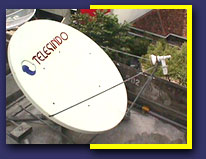
[ overview | pricing scheme | benefits of VSAT | typical VSAT application ]
OVERVIEW
VSAT technology is a telecommunication system based on wireless satellite technology. The term 'VSAT' stands for 'Very Small Aperture Terminal'. As the definition itself indicates, VSAT technology is made up of a small satellite earth station and a typical antenna of 1.8 meter diameter.
There
are three components in a VSAT network. The first is called the Master Earth
Station which is the network control center for the entire VSAT network.
The configuration, monitoring and management of the VSAT network are done
at this location.

The Master Earth Station also has a large six-meter antenna, a fully redundant electronics, self-contained backup power system, and a regulated air conditioning system. This Master Earth Station is manned 24 x 7 days throughout the year.
The
second component is the VSAT remote earth station. This is the hardware
installed at the customer's premises that includes the outdoor unit (ODU),
the indoor unit (IDU) and the interfacility link (IFL). The VSAT outdoor
unit consists of a standard 1.8 meter offset feed antenna, a solid state
amplifier (SSPA), a Low Noise Amplifier (LNA), and a Feedhorn. The indoor
unit is a VCR-sized unit that houses the communications electronics that
includes interface with the customer's equipment such as computers or
telephones. The IFL consists of coaxial cables that connects the outdoor
unit to the indoor unit.

The third component of a VSAT network is the satellite itself. All signals sent between the VSAT earth stations are beamed through the satellite. The VSAT system uses a geostationary satellite, which is orbiting at 36,000 km above the ground.

